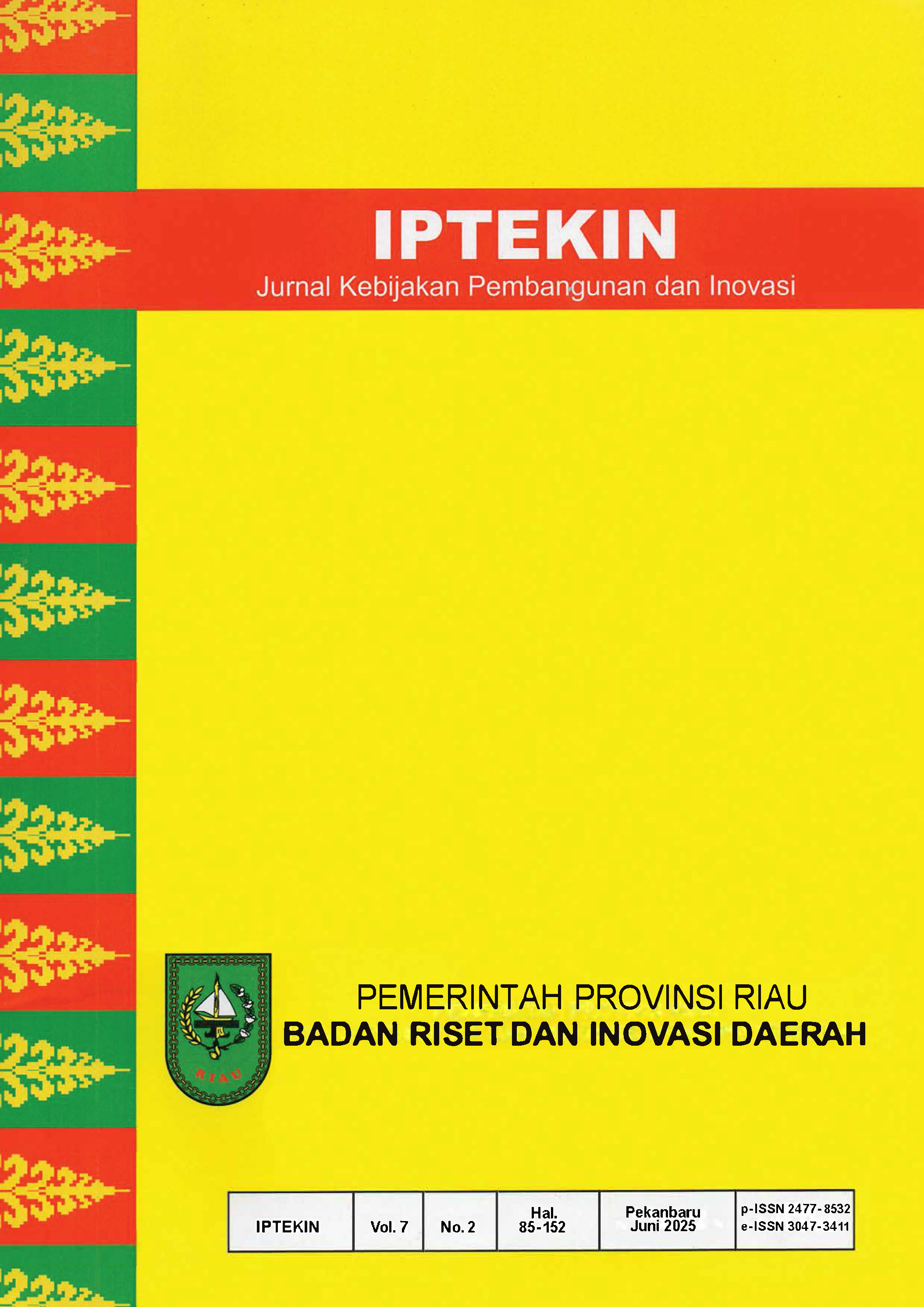Desain Sistem Drainase Perkotaan Sustainability dengan Pendekatan Saluran Bertingkat dan Grill Sampah di Kota Pekanbaru
Isi Artikel Utama
Abstrak
Banjir merupakan salah satu permasalahan utama di kawasan perkotaan, termasuk di Kota Pekanbaru, yang disebabkan oleh sistem drainase yang tidak memadai serta manajemen limbah padat yang kurang efektif. Penelitian ini bertujuan untuk merancang sistem drainase kota yang efisien, tahan lama, dan ramah lingkungan melalui pendekatan desain saluran bertingkat yang dilengkapi dengan grill penahan sampah. Metode penelitian yang digunakan adalah kuantitatif-deskriptif dengan tahapan studi literatur, survei lapangan, perancangan teknis menggunakan perangkat lunak CAD, serta simulasi aliran dan penyumbatan. Hasil penelitian menunjukkan bahwa sistem drainase yang dirancang dengan lebar 100 cm, kedalaman 120 cm, dan kemiringan dasar 0,18% mampu menampung debit puncak hingga 0,645 m³/detik. Sistem drainase bertingkat menggunakan grill sampah ini memberikan peningkatan laju aliran air hingga 35%, serta mengurangi potensi genangan di titik rawan banjir sebanyak 45%. Penerapan grill sampah dan sistem bertingkat terbukti efektif mengurangi potensi penyumbatan serta memudahkan pemeliharaan. Pendekatan ini bertujuan untuk pencapaian pembangunan drainase berkelanjutan dan mitigasi banjir yang adaptif di kawasan urban lainnya. Desain ini juga mendukung program strategis Pemerintah Kota Pekanbaru dalam pengendalian banjir, dan dapat direplikasi di kota lain dengan kondisi serupa.
Rincian Artikel

Artikel ini berlisensiCreative Commons Attribution-ShareAlike 4.0 International License.
Referensi
Adrian Pratama, & Rusli, Z. (2025). Pemeliharaan drainase di Kota Pekanbaru. Parlementer: Jurnal Studi Hukum Dan Administrasi Publik, 2(1), 105–117. https://doi.org/10.62383/parlementer.v2i1.527
Ahmad, S., Peng, X., Ashraf, A., Yin, D., Chen, Z., Ahmed, R., Israr, M., & Jia, H. (2025). Building resilient urban drainage systems by integrated flood risk index for evidence-based planning. Journal of Environmental Management, 374, 124130. https://doi.org/10.1016/j.jenvman.2025.124130
Ajayi, A. O., Oladiran, T. A., Oyerinde, I. A., Ajayi, A. O., & Fakanlu, A. B. (2024). Condition of drainage system and its impact on the residents of Mowe, Ogun State, Nigeria. CSID Journal of Infrastructure Development, 7(1). https://doi.org/10.7454/jid.v7.i1.1114
Anggraeni Cahyaningrum, P., Farhad Zakaria, M., & Jamal, A. (2024). Analisis pengambilan keputusan pembangunan sistem drainase untuk mengatasi banjir di Kota Surabaya. JMA, 2(5), 3031–5220. https://doi.org/10.62281
BPS Provinsi Riau. (2024). Statistik daerah Provinsi Riau 2024.
Dinas Pekerjaan Umum dan Penataan Ruang Kota Pekanbaru. (2022). Laporan Kinerja Instansi Pemerintah (LKJIP) 2022.
Dung, L. T., Le Phu, V., Lan, N. H. M., Tien, N. T. C., & Hiep, L. D. (2021). Sustainable urban drainage system model for the Nhieu Loc - Thi Nghe Basin, Ho Chi Minh City. IOP Conference Series: Earth and Environmental Science, 652(1), 012012. https://doi.org/10.1088/1755-1315/652/1/012012
Ferdowsi, A., & Behzadian, K. (2024). Urban drainage infrastructures toward a sustainable future. In M. A. Lotfollahi-Yaghin, M. Majidi, S. Mohammadi, & R. J. D. S. Díaz (Eds.), Sustainable structures and buildings (pp. 111–119). Springer. https://doi.org/10.1007/978-3-031-46688-5_8
Hakim, D. K., Gernowo, R., & Nirwansyah, A. W. (2024). Flood prediction with time series data mining: Systematic review. Natural Hazards Research, 4(2), 194–220. https://doi.org/10.1016/j.nhres.2023.10.001
IGS. (2023). Global sustainable development report.
Kumar, S., Agarwal, A., Ganapathy, A., Villuri, V., Pasupuleti, S., Kumar, D., Kaushal, D. R., Gosain, A., & Sivakumar, B. (2021). Impact of climate change on stormwater drainage in urban areas. Stochastic Environmental Research and Risk Assessment, 36, 1–20. https://doi.org/10.1007/s00477-021-02105-x
Li, C., Jiang, C., Chen, J., Lam, M. Y., Xia, J., & Ahmadian, R. (2025). An overview of flood evacuation planning: Models, methods, and future directions. Journal of Hydrology, 656, 133026. https://doi.org/10.1016/j.jhydrol.2025.133026
Monachese, A. P., Gómez-Villarino, M. T., López-Santiago, J., Sanz, E., Almeida-Ñauñay, A. F., & Zubelzu, S. (2025). Challenges and innovations in urban drainage systems: Sustainable drainage systems focus. Water (Switzerland), 17(1), 76. https://doi.org/10.3390/w17010076
Nugroho, A. (2025). Percepat penanganan banjir, Wako Pekanbaru jemput bola anggaran pusat. Pemerintah Kota Pekanbaru. https://www.pekanbaru.go.id/p/news/percepat-penanganan-banjir-wako-pekanbaru-jemput-bola-anggaran-pusat
Pamadi, M. (2023). The effects of poor drainage system in Batam road: A case in Nagoya, Batam. Civil Engineering and Architecture Journal, 1(2). https://doi.org/10.37253/leader.v1i2.8100
Pemerintah Provinsi Riau. (2018). Peraturan Daerah Rencana Tata Ruang Wilayah (RTRW) Riau 2018-2038 (Buku Rencana). https://www.researchgate.net/publication/340828128
Pemerintah Provinsi Riau. (2019). Peraturan Daerah Provinsi Riau Nomor 3 Tahun 2019 tentang Rencana Pembangunan Jangka Menengah Daerah (RPJMD) Provinsi Riau Tahun 2019-2024.
Putra, A., Wicaksono, A., Agustin, H. N., Agustina, N., Dewina, N., Putri, R., Kevin, F., & Pratama, T. (2021). Impact of drainage problems in the city of Jakarta. Journal of Global Environmental Dynamics, 2(1), 8–12.
Rahma, S., Sunarsih, & Mussadun. (2024). Assessing urban flooding and drainage system performance in urban area: A Mononobe equation and Manning formula approach. Jurnal Pengelolaan Sumberdaya Alam Dan Lingkungan (Journal of Natural Resources and Environmental Management), 14(3), 463-473. https://doi.org/10.29244/jpsl.14.3.463
Redaksi Setdako Pekanbaru. (2025, April). Wako Pekanbaru tinjau langsung kondisi kawasan Pasar Pagi Arengka pasca normalisasi drainase. Sekretariat Daerah Kota Pekanbaru. https://setdako.pekanbaru.go.id/web/detailberita/1412/wako-pekanbaru-tinjau-langsung-kondisi-kawasan-pasar-pagi-arengka-pasca-normalisasi-drainse
Roger, K. A., Tamim, A., & Herrmann, G. R. (2024). Urban drainage design.
Song, Y., Guo, L., Wang, C., Zhu, J., & Li, Z. (2024). Urban road waterlogging multi-level assessment integrated flood models and road network models. Transportation Research Part D: Transport and Environment, 133, 104305. https://doi.org/10.1016/j.trd.2024.104305
State of Florida Department of Transportation. (2021). Drainage design guide.
Tumpu, M. (2022). Drainase perkotaan. Yayasan Kita Menulis.
United Nations. (2023). Seizing the moment: Asia-Pacific disaster report 2023. The Economic and Social Commission for Asia and the Pacific. https://repository.unescap.org/handle/20.500.12870/6258
Wulandari, A. P., & Andriyus. (2024). Evaluasi pelaksanaan tugas Dinas Pekerjaan Umum dan Penataan Ruang Kota Pekanbaru dalam pemeliharaan saluran drainase di Pekanbaru. Jurnal Mahasiswa Pemerintahan, 1(3).
Zhang, Y., Wang, M., Zhang, D., Lu, Z., Bakhshipour, A. E., Liu, M., Jiang, Z., Li, J., & Tan, S. K. (2023). Multi-stage planning of LID-GREI urban drainage systems in response to land-use changes. Science of The Total Environment, 859, 160214. https://doi.org/10.1016/j.scitotenv.2022.160214

